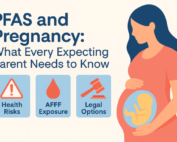Per- and polyfluoroalkyl substances (PFAS) are a group of synthetic chemicals used since the 1940s for their heat, water, and oil-resistant properties. These chemicals are found in many products, including firefighting foams, non-stick cookware, and water-repellent fabrics. Despite their utility, PFAS are persistent in the environment and human body, earning the nickname “forever chemicals.” This persistence has led to widespread contamination of water sources, posing significant health risks to communities across the United States.
PFAS Contamination in Water Sources
PFAS contamination has been detected in numerous municipal water systems and private wells throughout the U.S. The chemicals enter water supplies through various channels, including industrial discharges, use of firefighting foams, and leachate from landfills. Contaminated water sources pose serious health risks, including increased cancer risk, hormone disruption, and immune system impairment.
Several water systems in the U.S. have been identified as severely contaminated with PFAS. Here are some of the most affected areas:
| Contamination Site | Contamination Source | Impact | Health Risks |
| Cape Fear River Basin, North Carolina | Chemours Fayetteville Works facility | High levels of GenX, a type of PFAS, were detected in the Cape Fear River, affecting the drinking water of over 300,000 residents. | Elevated cancer risks and other health issues prompted widespread concern and litigation. |
| Hoosick Falls, New York | Manufacturing facilities operated by Saint-Gobain Performance Plastics and Honeywell International | Drinking water in Hoosick Falls was found to contain high levels of PFOA, leading to a state of emergency and provision of bottled water to residents. | Increased rates of kidney and testicular cancer, thyroid disease, and other health conditions. |
| Merrimack, New Hampshire | Saint-Gobain Performance Plastics | PFOA and PFOS contamination in the Merrimack Village District Water Works affected thousands of residents. | Similar health concerns as other affected areas, including increased cancer risk and reproductive issues. |
| Parkersburg, West Virginia | DuPont Washington Works facility | Extensive contamination with PFOA (C8) affected the Ohio River and local water supplies, leading to a significant legal battle and health study. | Documented health effects include cancer, ulcerative colitis, and developmental issues in children. |
| Colorado Springs, Colorado | Peterson Air Force Base firefighting foam | Widespread PFAS contamination in groundwater affected municipal and private wells in the Fountain Valley area. | Increased cancer risks and other serious health issues prompted community action and legal responses. |
Health Implications from PFAS Exposure
Exposure to PFAS has been linked to a variety of adverse health effects, including:
- Cancer: Increased risk of kidney, testicular, and possibly other cancers.
- Endocrine Disruption: Altered thyroid hormone levels and potential reproductive effects.
- Immune System Effects: Reduced vaccine response and increased risk of infections.
- Liver Damage: Elevated liver enzymes indicating potential liver damage.
- Cholesterol Levels: Increased cholesterol levels, contributing to cardiovascular risks.
Current Lawsuits and Legal Actions
Numerous lawsuits have been filed across the country against manufacturers and users of PFAS, seeking compensation for contamination and health damages. Here are some notable legal actions:
Chemours and DuPont
- Overview: Chemours and DuPont have faced multiple lawsuits related to PFAS contamination from their facilities. The companies have been accused of knowingly contaminating water supplies and failing to disclose the risks.
- Settlements: In 2017, DuPont and Chemours agreed to a $671 million settlement to resolve 3,550 personal injury claims related to PFOA contamination in Parkersburg, West Virginia.
3M Company
- Overview: 3M, a major manufacturer of PFAS, has been sued by several states and municipalities for contaminating water supplies with PFOS and PFOA. The company has faced allegations of knowingly releasing harmful chemicals into the environment.
- Settlements: In 2018, 3M agreed to pay $850 million to settle a lawsuit with the state of Minnesota over PFAS contamination in the Twin Cities area.
Saint-Gobain Performance Plastics
- Overview: Saint-Gobain has faced multiple lawsuits for PFAS contamination from its manufacturing facilities in New York and New Hampshire. The company has been accused of causing widespread water contamination and health risks.
- Settlements & Ongoing Cases: Saint-Gobain has been involved in several settlements and ongoing legal battles, including a significant settlement with the state of New York for Hoosick Falls contamination.
Military Installations
- Overview: Numerous lawsuits have been filed against the Department of Defense for PFAS contamination from the use of firefighting foams (AFFF) at military bases. These cases involve contaminated water supplies affecting military personnel and surrounding communities.
- Ongoing Actions: Litigation is ongoing, with various individual claims seeking compensation for health effects and environmental cleanup. Hundreds of thousands of military veterans and their dependents are thought to be affected by AFFF contaminated water.
Regulatory and Remediation Efforts
The growing recognition of PFAS as a significant environmental and public health threat has prompted regulatory actions and remediation efforts at both state and federal levels.
Federal Actions
- EPA Guidelines: The Environmental Protection Agency (EPA) has established health advisories for PFOA and PFOS in drinking water. The limit was set at 70 parts per trillion (ppt) in 2016 but has since lowered to 4 parts per trillion (ppt) as further research ties serious cancers and illnesses to consuming lesser concentrations of these chemicals. The agency is also working on setting enforceable limits and expanding PFAS monitoring and regulation.
- Legislation: The PFAS Action Act of 2021 and other legislative efforts aim to regulate PFAS as hazardous substances, enforce stricter standards, and fund cleanup efforts.
State Initiatives
- Stringent Standards: Several states have adopted strict PFAS drinking water standards as well. For example, New Jersey has set maximum contaminant levels (MCLs) of 14 ppt for PFOA and 13 ppt for PFOS.
- Comprehensive Testing: States like Michigan have implemented extensive testing programs to identify and address PFAS contamination in public water systems and private wells.
PFAS Remediation and Cleanup
- Filtration Systems: Activated carbon and reverse osmosis filtration systems are commonly used to remove PFAS from contaminated water supplies.
- Site Remediation: Efforts are underway to clean up contaminated sites, including soil and groundwater remediation, to prevent further PFAS migration into water supplies.
Community Response and Advocacy
Communities affected by PFAS contamination have been proactive in advocating for safer water and holding polluters accountable. Key actions include:
- Public Awareness Campaigns: Educating residents about the risks of PFAS exposure and the importance of testing and remediation.
- Legal Action: Filing lawsuits against manufacturers and responsible parties to seek compensation and fund cleanup efforts.
- Legislative Advocacy: Pushing for stronger regulations and funding for PFAS research, testing, and remediation at local, state, and federal levels.
Conclusion
PFAS contamination in municipal water systems and private wells is a critical public health issue affecting millions of Americans. Understanding the sources and health risks associated with PFAS exposure is crucial for communities to take appropriate actions.
Ongoing legal battles and regulatory efforts aim to address the contamination and hold responsible parties accountable. By staying informed and advocating for safer water, communities can mitigate the impact of these persistent chemicals and protect their families’ health.






